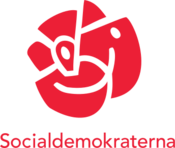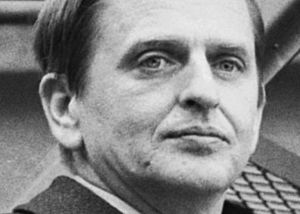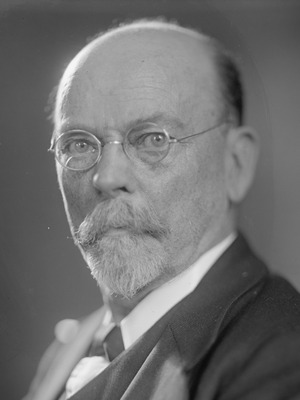Swedish Social Democratic Party facts for kids
Quick facts for kids <div style="padding-top:0.3em; padding-bottom:0.3em; border-top:2px solid Lua error in Module:European_and_national_party_data/config at line 227: attempt to index field 'data' (a nil value).; border-bottom:2px solid Lua error in Module:European_and_national_party_data/config at line 227: attempt to index field 'data' (a nil value).; line-height: 1;">
Swedish Social Democratic Workers' Party
Sveriges socialdemokratiska arbetareparti
|
|
|---|---|
 |
|
| Abbreviation | S SAP |
| Chairperson | Magdalena Andersson |
| Secretary-General | Tobias Baudin |
| Parliamentary group leader | Lena Hallengren |
| Founded | 23 April 1889 |
| Headquarters | Sveavägen 68, Stockholm |
| Student wing | Social Democratic Students of Sweden |
| Youth wing | Swedish Social Democratic Youth League |
| Women's wing | Social Democratic Women in Sweden |
| Religious wing | Religious Social Democrats of Sweden |
| LGBT wing | LGBT Social Democrats of Sweden |
| Membership (2023) | |
| Ideology | Social democracy |
| Political position | Centre-left |
| European affiliation | Party of European Socialists |
| International affiliation | Progressive Alliance |
| European Parliament group | Progressive Alliance of Socialists and Democrats |
| Nordic affiliation | SAMAK The Social Democratic Group |
| Colours | Red |
| Riksdag | Lua error in Module:European_and_national_party_data/config at line 227: attempt to index field 'data' (a nil value). |
| European Parliament | Lua error in Module:European_and_national_party_data/config at line 227: attempt to index field 'data' (a nil value). |
| County councils |
576 / 1,720
|
| Municipal councils |
3,771 / 12,614
|
| Website | |
| Lua error in Module:European_and_national_party_data/config at line 227: attempt to index field 'data' (a nil value). | |
The Swedish Social Democratic Party, often called The Social Democrats, is a major political party in Sweden. Its full name is the Swedish Social Democratic Workers' Party. The party believes in social democracy, which means they aim for a society where everyone is treated fairly and has equal opportunities. They are part of international groups like the Progressive Alliance and the Party of European Socialists.
The Social Democrats were started in 1889, making them the oldest and currently largest party in Sweden. For many years, from the 1930s to the 1980s, they were very popular, often winning more than 40% of the votes. They were in charge of the government for a long time, from 1932 to 1976 without a break. They also led the government for most of the time between 1982 and 2022.
Since 2022, the party has been in the opposition. The current leader of the Social Democrats is Magdalena Andersson. She made history by becoming Sweden's first female Prime Minister in 2021.
Contents
A Look at the Party's History
The Social Democrats were founded in 1889. In 1917, some members left to form a different party, which is now called the Left Party. The Social Democrats believe in "freedom, equality, and solidarity" (meaning working together and supporting each other).
In the early 1900s, more people, especially working-class people, gained the right to vote. This helped the Social Democrats grow stronger. They worked with trade unions (groups that protect workers' rights) and other community groups. Unlike in some other countries, Swedish socialists were able to form a strong government early on.
A key leader named Hjalmar Branting helped the party be flexible and practical. They were willing to work with other groups, like liberals and farmers. During the Great Depression, the party used economic ideas that helped the country recover.
In 2007, Mona Sahlin became the first woman to lead the Social Democratic Party. Before the 2010 election, they teamed up with the Greens and the Left Party in an alliance called the Red–Greens. However, they lost that election, and the alliance later ended.
What the Party Believes In

The Social Democrats' main goal is to create a "democratic socialist" society. This means they want an economy where decisions are made democratically, and resources are shared based on what people need and what they can contribute.
Since they have been in power for much of Sweden's history, their ideas have greatly shaped Swedish politics. Their beliefs grew from strong movements in the late 1800s, like workers' rights groups and groups promoting temperance (avoiding alcohol). These movements helped ordinary people get involved in politics early on.
The Social Democrats strongly support egalitarianism, which means believing that all people are equal and deserve equal rights and opportunities. They are also against discrimination and racism. They believe in providing social welfare (like healthcare and education) for everyone, paid for by progressive taxation (where people with higher incomes pay a larger percentage in taxes).
They also support a "social corporatist" economy. This means that businesses and worker groups work together, with the government helping to solve any disagreements. The party also wants to end the monarchy in Sweden.
Ideas from Liberalism

Ideas from Liberalism have also influenced the Social Democrats, especially the idea of security. Tage Erlander, who was Prime Minister for a long time (1946–1969), said that security is "too big a problem for the individual to solve with only his own power." This means the government should help make sure everyone feels safe and secure.
Early leaders like Hjalmar Branting believed that making reforms to improve workers' lives was more helpful than waiting for a big revolution.
Changing Their Ideas
Over time, the Social Democrats changed their definition of "socialization" (which usually means common ownership of businesses). They started to see it as increasing "democratic influence over the economy" instead. This allowed them to work with other parties and govern more effectively.
They also managed to get the middle class to support them by seeing them as "working people" who also needed support. They even worked with small farmers. The party's 1932 election plan said they wouldn't just help one group of workers but would support all "working people," including farmers, shop clerks, and teachers.
The Social Democrats also used ideas from Swedish nationalists to make people feel at home in Sweden. Per Albin Hansson, a famous leader, said in 1928 that "there is no more patriotic party than the [Social Democrats] since the most patriotic act is to create a land in which all feel at home." This idea was called the Folkhemmet, or the People's Home. It meant creating a society where everyone felt like they belonged and were treated equally.
Building the Welfare State

The Social Democratic Party is known for building Sweden's welfare state after World War II. This system includes progressive taxation, fair trade, and policies to keep unemployment low. Sweden recovered well from the Great Depression thanks to economic plans suggested by Social Democratic economists.
They developed a system called the Rehn-Meidner model in the 1940s and 1950s. This model helped set fair wages and encouraged businesses to be efficient. It also helped workers get new training and move to new jobs if their old ones were no longer needed. The government also worked to ensure "equal pay for equal work" and kept incomes rising, while taxing higher earners more to fund public services.
These policies have influenced other countries. For example, some ideas from Sweden's social democracy helped inspire similar movements in the United States.
During the 20th century, under Social Democratic leadership, Sweden remained neutral in major wars, including the Cold War. This helped Sweden's economy grow while other European countries were struggling.
Later, under Prime Minister Olof Palme, Sweden openly criticized the United States' actions in Vietnam. In 2003, a top Social Democratic politician, Anna Lindh, who spoke out against the Iraq War, tragically died in Stockholm. Her death was a big loss for the party.
Changes in Economic Ideas
In the 1970s, workers in very successful companies started asking for a share of the profits. This led to a proposal in 1976 to put these extra profits into investment funds controlled by the workers. However, business owners strongly opposed this idea, seeing it as too socialist.
The 1980s were a challenging time for Sweden and the Social Democrats. Many industries changed, and Olof Palme was tragically assassinated in 1986. Swedish businesses also started investing more in other European countries. The party began to move away from some of its earlier policies, like very high marginal taxes.

When the Social Democrats returned to power in 1994, they had to deal with an economic crisis. They made changes to the welfare state and allowed some public services to be run by private companies. They also supported Sweden joining the European Union (EU), which happened in 1994.
The 21st Century
In the 21st century, many parts of Sweden's welfare state continued to work well. This was partly because many people were part of trade unions, and there was strong public support for social services. The Social Democrats made some changes, like reducing certain taxes and increasing taxes on high earners. They also increased spending on child support. By the late 1990s, Sweden's economy was strong, and there was low inequality.
The Social Democratic Party also works on environmentalist and feminist policies. These policies aim to create healthy and fair conditions for everyone. For example, they have supported paid maternity and paternity leave, good jobs for women in the public sector, and policies to encourage women's involvement in politics.
In the 2006 Swedish general election, the Social Democrats lost to a group of centre-right parties. This was their smallest share of votes in a general election since everyone gained the right to vote. Mona Sahlin became party leader in 2007.
After losing again in the 2010 Swedish general election, the party went through its longest time in opposition since before 1936. Stefan Löfven became party leader in 2012. He led the party to form a government with the Green Party in 2014, and he became Prime Minister.
In the 2018 Swedish general election, the Social Democrats' vote share dropped to 28.3%, their lowest since 1908. However, they still formed a government with the Green Party. In 2021, Stefan Löfven resigned, and Magdalena Andersson became the new leader. On November 30, 2021, she became Sweden's first female Prime Minister.
In October 2022, the Social Democrats moved into opposition again, even though they remained Sweden's largest party.
Election Results
These tables show how the Social Democratic Party has performed in elections over the years, including how many votes and seats they won.
Riksdag (Swedish Parliament)
| Election | Leader | Votes | % | Seats | +/– | Status |
|---|---|---|---|---|---|---|
| 1896 | Claes Tholin | 206 | 0.1 (#5) |
1 / 230
|
Opposition | |
| 1899 | 313 | 0.2 (#5) |
1 / 230
|
Opposition | ||
| 1902 | 6,321 | 3.5 (#3) |
4 / 230
|
Opposition | ||
| 1905 | 20,677 | 9.5 (#3) |
13 / 230
|
Opposition | ||
| 1908 | Hjalmar Branting | 45,155 | 14.6 (#3) |
34 / 230
|
Opposition | |
| 1911 | 172,196 | 28.5 (#3) |
64 / 230
|
Opposition | ||
| Mar 1914 | 228,712 | 30.1 (#3) |
73 / 230
|
Opposition | ||
| Sep 1914 | 266,133 | 36.4 (#2) |
87 / 230
|
Opposition | ||
| 1917 | 228,777 | 31.1 (#1) |
86 / 230
|
Coalition | ||
| 1920 | 195,121 | 29.6 (#1) |
75 / 230
|
Opposition | ||
| 1921 | 630,855 | 36.2 (#1) |
93 / 230
|
Minority (1921–1923) | ||
| Opposition (1923–1924) | ||||||
| 1924 | 725,407 | 41.1 (#1) |
104 / 230
|
Minority (1924–1926) | ||
| Opposition (1926–1928) | ||||||
| 1928 | Per Albin Hansson | 873,931 | 37.0 (#1) |
90 / 230
|
Opposition | |
| 1932 | 1,040,689 | 41.7 (#1) |
104 / 230
|
Minority (1932–1936) | ||
| Opposition (1936) | ||||||
| 1936 | 1,338,120 | 45.9 (#1) |
112 / 230
|
Coalition | ||
| 1940 | 1,546,804 | 53.8 (#1) |
134 / 230
|
Coalition | ||
| 1944 | 1,436,571 | 46.6 (#1) |
115 / 230
|
Majority | ||
| 1948 | Tage Erlander | 1,789,459 | 46.1 (#1) |
112 / 230
|
Minority | |
| 1952 | 1,729,463 | 46.1 (#1) |
110 / 230
|
Coalition | ||
| 1956 | 1,729,463 | 44.6 (#1) |
106 / 231
|
Coalition | ||
| 1958 | 1,776,667 | 46.2 (#1) |
111 / 231
|
Minority | ||
| 1960 | 2,033,016 | 47.8 (#1) |
114 / 232
|
Minority | ||
| 1964 | 2,006,923 | 47.3 (#1) |
113 / 233
|
Minority | ||
| 1968 | 2,420,242 | 50.1 (#1) |
125 / 233
|
Majority | ||
| 1970 | Olof Palme | 2,256,369 | 45.3 (#1) |
163 / 350
|
Minority | |
| 1973 | 2,247,727 | 43.6 (#1) |
156 / 350
|
Minority | ||
| 1976 | 2,324,603 | 42.7 (#1) |
152 / 349
|
Opposition | ||
| 1979 | 2,356,234 | 43.2 (#1) |
154 / 349
|
Opposition | ||
| 1982 | 2,533,250 | 45.6 (#1) |
166 / 349
|
Minority | ||
| 1985 | 2,487,551 | 44.7 (#1) |
159 / 349
|
Minority | ||
| 1988 | Ingvar Carlsson | 2,321,826 | 43.2 (#1) |
156 / 349
|
Minority | |
| 1991 | 2,062,761 | 37.7 (#1) |
138 / 349
|
Opposition | ||
| 1994 | 2,513,905 | 45.2 (#1) |
161 / 349
|
Minority | ||
| 1998 | Göran Persson | 1,914,426 | 36.4 (#1) |
131 / 349
|
Minority | |
| 2002 | 2,113,560 | 39.9 (#1) |
144 / 349
|
Minority | ||
| 2006 | 1,942,625 | 35.0 (#1) |
130 / 349
|
Opposition | ||
| 2010 | Mona Sahlin | 1,827,497 | 30.7 (#1) |
112 / 349
|
Opposition | |
| 2014 | Stefan Löfven | 1,932,711 | 31.0 (#1) |
113 / 349
|
Coalition | |
| 2018 | 1,830,386 | 28.3 (#1) |
100 / 349
|
Coalition (2018–2021) | ||
| Minority (2021–2022) | ||||||
| 2022 | Magdalena Andersson | 1,964,474 | 30.3 (#1) |
107 / 349
|
Opposition |
European Parliament Elections
| Election | List leader | Votes | % | Seats | +/− | EP Group |
|---|---|---|---|---|---|---|
| 1995 | Maj Britt Theorin | 752,817 | 28.06 (#1) |
7 / 22
|
New | PES |
| 1999 | Pierre Schori | 657,497 | 25.99 (#1) |
6 / 22
|
||
| 2004 | Inger Segelström | 616,963 | 24.56 (#1) |
5 / 19
|
||
| 2009 | Marita Ulvskog | 773,513 | 24.41 (#1) |
5 / 18
6 / 20
|
|
S&D |
| 2014 | 899,074 | 24.19 (#1) |
5 / 20
|
|||
| 2019 | Heléne Fritzon | 974,589 | 23.48 (#1) |
5 / 20
|
||
| 2024 | 1,037,090 | 24.77 (#1) |
5 / 20
|

How Different Groups Voted
This table shows how different groups of voters supported the Social Democrats in recent elections.
|
|
Percentage of which voting for the Social Democrats | |||||
| Group/Gender | 2002 | 2006 | 2010 | 2014 | 2018 | 2022 |
|---|---|---|---|---|---|---|
| Blue-collar workers | 50 | 45 | 41 | 39 | 34 | 32 |
| White-collar workers | 32 | 24 | 20 | 24 | 27 | 32 |
| Businessmen and farmers | 18 | 13 | 16 | 15 | 13 | 19 |
| Male | 38 | 30 | 25 | 30 | 25 | 26 |
| Female | 37 | 31 | 29 | 32 | 31 | 34 |
| Source: | ||||||
How the Party is Organized
The Social Democrats have been the largest party in the Riksdag (Swedish Parliament) since 1914. Many different kinds of people support the party, especially blue-collar workers (people who do manual labor) and those who work in the public sector (like teachers or nurses). The party has a strong connection with the Swedish Trade Union Confederation (LO), which is a big union for workers.
Here are some of the groups that are part of the Swedish Social Democratic movement:
- The Social Democratic Women in Sweden (S-kvinnor) is for women.
- The Swedish Social Democratic Youth League is for young people.
- The Social Democratic Students of Sweden is for university students.
- The Religious Social Democrats of Sweden is for members with religious beliefs.
- The LGBT Social Democrats of Sweden is for queer people.
The party had a very successful period from the mid-1930s to the mid-1980s. During this time, they often won around 45% of the votes, making them one of the most successful parties in democratic countries. In 1940 and 1968, they even won more than 50% of the votes.
The Social Democrats get support from many different people across Sweden. However, they are especially strong among organized blue-collar workers.
Recent Changes in Support
In the 2006 Swedish general election, the Social Democrats received their lowest share of votes (34.99%) since everyone gained the right to vote. This caused them to lose power to a group of centre-right parties. They lost support from older people and some union members.
From 2006 to 2014, the Social Democrats lost two elections in a row. Some of their voters started supporting other parties, including the right-wing populist party, Sweden Democrats.
In the 2018 Swedish general election, the Social Democrats' vote share dropped to 28.3%, which was their lowest since 1908. However, in the 2022 Swedish general election, they remained Sweden's largest party with 30.3% of the vote. Even so, a group of right-wing parties won a small majority in parliament, so the Social Democrats are currently in opposition.
Party Leaders
| Party leader | Period | Party secretary | |
|---|---|---|---|
| Claes Tholin |
|
|
Karl Magnus Ziesnitz Carl Gustaf Wickman |
| First party leader after collective leadership. | |||
| Hjalmar Branting |
|
|
Carl Gustaf Wickman Fredrik Ström Gustav Möller |
| Prime Minister (1920, 1921–1923 and 1924–1925). Died in office. | |||
| Per Albin Hansson |
|
|
Gustav Möller Torsten Nilsson Sven Andersson |
| Prime Minister (1932–1936 and 1936–1946). Died in office. | |||
| Tage Erlander |
|
|
Sven Andersson Sven Aspling Sten Andersson |
| Prime Minister (1946–1969). Longest-serving Prime Minister in Swedish history. | |||
| Olof Palme |
|
|
Sten Andersson Bo Toresson |
| Prime Minister (1969–1976 and 1982–1986). Tragically died. | |||
| Ingvar Carlsson |
|
|
Bo Toresson Mona Sahlin Leif Linde |
| Prime Minister (1986–1991 and 1994–1996). | |||
| Göran Persson |
|
|
Ingela Thalén Lars Stjernkvist Marita Ulvskog |
| Prime Minister (1996–2006). | |||
| Mona Sahlin |
|
|
Marita Ulvskog Ibrahim Baylan |
| First female leader of the party. | |||
| Håkan Juholt |
|
|
Carin Jämtin |
| Resigned after a political issue. | |||
| Stefan Löfven |
|
|
Carin Jämtin Lena Rådström Baastad |
| Prime Minister (2014–2021) | |||
| Magdalena Andersson |
|
Tobias Baudin | |
| Prime Minister (2021–2022) | |||
Notable People
- Hildur Humla (1889–1969), a Swedish politician and member of the Social Democratic Party.
See also
 In Spanish: Partido Socialdemócrata Sueco para niños
In Spanish: Partido Socialdemócrata Sueco para niños
- Arbetarnas bildningsförbund
- Aktuellt i Politiken
- Welfare in Sweden
Images for kids




